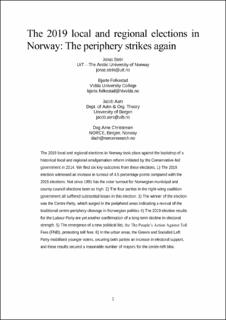| dc.contributor.author | Stein, Jonas | |
| dc.contributor.author | Folkestad, Bjarte | |
| dc.contributor.author | Christensen, Dag Arne | |
| dc.contributor.author | Aars, Jacob | |
| dc.date.accessioned | 2022-12-01T14:21:36Z | |
| dc.date.available | 2022-12-01T14:21:36Z | |
| dc.date.created | 2020-11-19T08:45:18Z | |
| dc.date.issued | 2020 | |
| dc.identifier.citation | Regional & Federal Studies. 2020, 1-13. | en_US |
| dc.identifier.issn | 1359-7566 | |
| dc.identifier.uri | https://hdl.handle.net/11250/3035413 | |
| dc.description.abstract | The 2019 local and regional elections in Norway took place against the backdrop of a historical local and regional amalgamation reform initiated by the Conservative-led government in 2014. We find six key outcomes from these elections. (1) The 2019 election witnessed an increase in turnout of 4.5 percentage points compared with the 2015 elections. This is the highest voter turnout in local and regional elections since 1991. (2) The four parties in government all suffered substantial losses. (3) The winner of the election was the Centre Party, which surged in the peripheral areas (4) The 2019 election results for the Labour Party are yet another confirmation of a long-term decline in electoral strength. (5) The emergence of a new political list, The People’s Action Against Toll Fees (FNB). (6) In the urban areas, the Greens and Socialist Left Party mobilized younger voters, securing both parties an increase in electoral support. | en_US |
| dc.language.iso | eng | en_US |
| dc.title | The 2019 local and regional elections in Norway: The periphery strikes again | en_US |
| dc.type | Peer reviewed | en_US |
| dc.type | Journal article | en_US |
| dc.description.version | acceptedVersion | en_US |
| dc.source.pagenumber | 1-13 | en_US |
| dc.source.journal | Regional & Federal Studies | en_US |
| dc.identifier.doi | 10.1080/13597566.2020.1840364 | |
| dc.identifier.cristin | 1849622 | |
| dc.relation.project | Norges forskningsråd: 294597 | en_US |
| cristin.ispublished | true | |
| cristin.fulltext | postprint | |
| cristin.qualitycode | 1 | |
